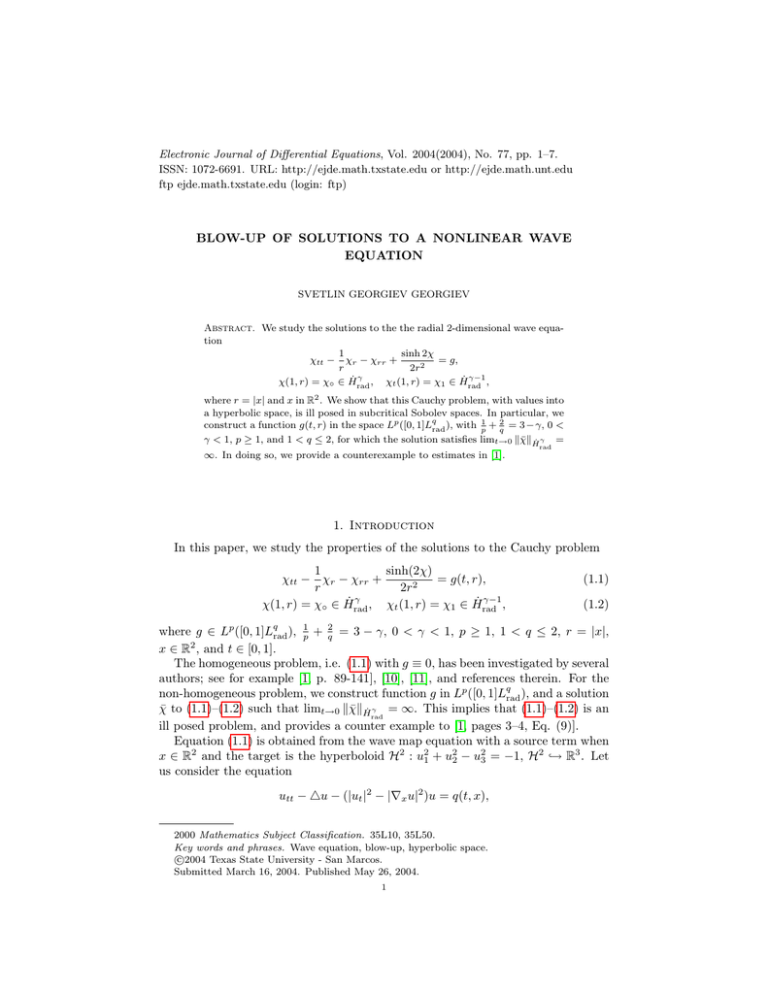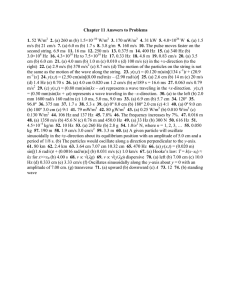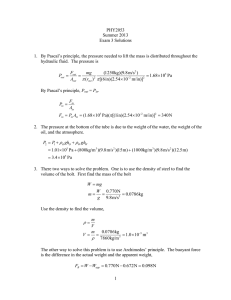Electronic Journal of Differential Equations, Vol. 2004(2004), No. 77, pp.... ISSN: 1072-6691. URL: or
advertisement

Electronic Journal of Differential Equations, Vol. 2004(2004), No. 77, pp. 1–7. ISSN: 1072-6691. URL: http://ejde.math.txstate.edu or http://ejde.math.unt.edu ftp ejde.math.txstate.edu (login: ftp) BLOW-UP OF SOLUTIONS TO A NONLINEAR WAVE EQUATION SVETLIN GEORGIEV GEORGIEV Abstract. We study the solutions to the the radial 2-dimensional wave equation 1 sinh 2χ = g, χtt − χr − χrr + r 2r 2 γ γ−1 χ(1, r) = χ◦ ∈ Ḣrad , χt (1, r) = χ1 ∈ Ḣrad , where r = |x| and x in R2 . We show that this Cauchy problem, with values into a hyperbolic space, is ill posed in subcritical Sobolev spaces. In particular, we construct a function g(t, r) in the space Lp ([0, 1]Lqrad ), with p1 + 2q = 3 − γ, 0 < γ < 1, p ≥ 1, and 1 < q ≤ 2, for which the solution satisfies limt→0 kχ̄kḢ γ = rad ∞. In doing so, we provide a counterexample to estimates in [1]. 1. Introduction In this paper, we study the properties of the solutions to the Cauchy problem 1 sinh(2χ) χtt − χr − χrr + = g(t, r), r 2r2 γ γ−1 χ(1, r) = χ◦ ∈ Ḣrad , χt (1, r) = χ1 ∈ Ḣrad , (1.1) (1.2) where g ∈ Lp ([0, 1]Lqrad ), p1 + 2q = 3 − γ, 0 < γ < 1, p ≥ 1, 1 < q ≤ 2, r = |x|, x ∈ R2 , and t ∈ [0, 1]. The homogeneous problem, i.e. (1.1) with g ≡ 0, has been investigated by several authors; see for example [1, p. 89-141], [10], [11], and references therein. For the non-homogeneous problem, we construct function g in Lp ([0, 1]Lqrad ), and a solution χ̄ to (1.1)–(1.2) such that limt→0 kχ̄kḢ γ = ∞. This implies that (1.1)–(1.2) is an rad ill posed problem, and provides a counter example to [1, pages 3–4, Eq. (9)]. Equation (1.1) is obtained from the wave map equation with a source term when x ∈ R2 and the target is the hyperboloid H2 : u21 + u22 − u23 = −1, H2 ,→ R3 . Let us consider the equation utt − 4u − (|ut |2 − |∇x u|2 )u = q(t, x), 2000 Mathematics Subject Classification. 35L10, 35L50. Key words and phrases. Wave equation, blow-up, hyperbolic space. c 2004 Texas State University - San Marcos. Submitted March 16, 2004. Published May 26, 2004. 1 2 SVETLIN G. GEORGIEV EJDE-2004/77 when x ∈ R2 and the target is the hyperboloid H2 : u21 + u22 − u23 = −1, H2 ,→ R3 . Equation (1) is a wave map equation with a source term, where |ut |2 = u21t + u22t − u23t , |∇x u|2 = |∇x1 u|2 + |∇x2 u|2 , |∇xi u|2 = u21xi + u22xi − u23xi , i = 1, 2. Let q = (q1 , q2 , q3 ), with sinh3 χ cos φ1 1 sinh χ cos φ + , 1 r2 r2 1 sinh3 χ sin φ1 q2 = cosh χ sin φ1 (χtt − ∆χ) + 2 sinh χ sin φ1 + , r r2 q3 = sinh χg. q1 = cosh χ cos φ1 (χtt − ∆χ) + For the hyperboloid H2 , we have the parametric representation u = (u1 , u2 , u3 ), (1.3) u1 = sinh χ cos φ1 , (1.4) u2 = sinh χ sin φ1 , (1.5) χ ≥ 0, (1.6) u3 = cosh χ, φ1 ∈ [0, 2π]. Let x1 = r cos φ1 , x2 = r sin φ1 . Then from (1), we get that χ satisfies (1.1). Our main result is as follows. Theorem 1.1. Let p1 + 2q = 3 − γ, p ≥ 1, 1 < q ≤ 2, 0 < γ < 1. Then there exist function g ∈ Lp ([0, 1]Lqrad ) and solution χ̄ to (1.1)–(1.2) such that lim kχ̄kḢ γ = ∞. t→0 rad Note that the case p = 1, q = 2 which is the energy case can not be reached by the setting in this theorem. 2. Preliminary results Let f be a real-valued function satisfying (H1) f ∈ C 2 [0, ∞), (H2) f (0) = 0, f (1) = f 0 (1) = 0. As an example of a function satisfying (H1)-(H2), we have f (x) = (1 − x)2 x. (2.1) Certainly f ∈ C 2 [0, ∞); therefore, (H1) holds. Note that f (0) = 0 and f 0 (x) = −2(1 − x)x + (1 − x)2 thus f (1) = f 0 (1) = 0; therefore, (H2) holds. In addition, assume that: (H3) p1 + 2q = 3 − γ, 0 < γ < 1, p ≥ 1, q > 1 (H4) 0 < α ≤ 2 − q, β > 0 β q < 2p(q−1) or β < α with (H5) Either β > α with α β α Note that when (H3) holds, q ≤ 2; because if q > 2 then from where γ > 1 which contradicts 0 < γ < 1. q(2p−1) . 2p 3 − γ = p1 + 2q > < 1 + 1 = 2, EJDE-2004/77 BLOW-UP OF SOLUTIONS Let z 1/α = r . tβ/α Then z 2/α = 3 r2 , t2β/α ∂z 2/α 2β 1 2/α ∂ 2 z 2/α 2β(α + 2β) 1 2/α =− z , = z , 2 ∂t α t ∂t α2 t2 ∂z 2/α 2 1 2 ∂ 2 z 2/α = β zα, = 2β . 2 ∂r ∂r α t tα Let f be a function satisfying (H1)–(H2) and let ( f (r2 ) for r ≤ 1, χ◦ = 0 for r ≥ 1, ( 2 0 2 − 2β α r f (r ) for r ≤ 1, χ1 = 0 for r ≥ 1, 4β 2 4/α 00 2/α 2β(α + 2β) 2/α 0 2/α z f z + z f z , α2 α2 B2 = z 2/α f 00 (z 2/α ) + f 0 (z 2/α ), ( sinh(2χ̄) B1 4 for r ≤ tβ/α , 2 − t2β/α B2 + 2r 2 g= t 0 for r ≥ tβ/α , B1 = (2.2) (2.3) (2.4) (2.5) (2.6) and let ( f (z 2/α ) for r ≤ tβ/α χ̄ = 0 for r ≥ tβ/α . (2.7) Note that χ̄ is a solution of (1.1)–(1.2). Indeed, for z ≤ 1 we have 2β 2/α 0 2/α z f (z ), tα 4β 2 1 4 2β(α + 2β) z 2/α 0 2/α f (z ), χ̄tt = 2 2 z α f 00 (z 2/α ) + α t α2 t2 2 1 χ̄r = β/α z α f 0 (z 2/α ), t 2 4 2/α 00 2/α χ̄rr = 2β z f (z ) + 2β f 0 (z 2/α ). tα tα Then, for z ≤ 1, we have χ̄t = − sinh(2χ̄) 1 sinh 2χ̄ B1 4 χ̄tt − χ̄r − χ̄rr + = 2 − 2β B2 + ≡ g, 2 r 2r t 2r2 tα Lemma 2.1. Under Assumptions (H1)-(H5), the function g defined by (2.6) is in the space Lp ([0, 1]Lqrad ). Proof. Note that kgkqLq rad Z tβ/α q Z |g| r dr = = 0 tβ/α sinh(2χ̄) q 4 B1 2 − 2β B2 + r dr. t 2r2 tα 0 1 By making the change of variable r = z α tβ/α , 1 1 dr = tβ/α z α −1 dz, α 2β r dr = t α 1 2 −1 z α dz α 4 SVETLIN G. GEORGIEV EJDE-2004/77 (with t fixed) and 2β kgkqLq rad Z 1 4 sinh(2χ̄) q 2 −1 1 B1 2 − 2β B2 + 2β z α dz t tα 2t α z 2/α 0 2β 2β Z Z 2 2 t α −2q 1 t α (1−q) 1 q α −1 ≤ c1 |B1 | z dz + c2 |B2 |q z α −1 dz α α 0 0 2β (1−q) Z 1 q α t sinh(2χ̄) α2 −1 dz. + c3 z α 2z 2/α 0 = tα α Let Z I1 = 1 Z 2 |B1 |q z α −1 dz, 1 0 2 |B2 |q z α −1 dz, I2 = I3 = 0 Z 1 sinh(2χ̄) q α2 −1 dz. z 2z 2/α 0 From the definition of B1 and B2 and since (H1) and (H4) hold (we note that 2 2 α ∈ (0, 1) because 1 < q ≤ 2), we have |B1 |q z α −1 ∈ C[0, 1], |B2 |q z α −1 ∈ C[0, 1]. Then I1 < ∞, I2 < ∞. Now we consider I3 . Let B be constant for which B − 2 cosh(2χ̄)χ̄0 ≥ 0. Such a constant B exists because χ̄(z 2/α ) and χ̄0 (z 2/α ) are bounded functions for z ∈ [0, 1] and supp χ̄ ⊂ [0, 1], supp χ̄0 ⊂ [0, 1]. Let p(z) = Bz 2/α − sinh(2χ̄). Then 2 2 −1 z α (B − 2 cosh(2χ̄)χ̄0 ) ≥ 0 ∀z ∈ [0, 1]. α Consequently, p(z) is an increasing function for z ∈ [0, 1]. Therefore, p(z) ≥ p(0) = 0 for all z ∈ [0, 1] or Bz 2/α ≥ sinh(2χ̄) for z ∈ [0, 1]. Then Z 1 2/α q 2 Bz I3 ≤ 2/α z α −1 dz ≡ const < ∞. 2z 0 Consequently, 2β 2β kgkqLq ≤ c̄1 t α −2q + c̄2 t α (1−q) p0 (z) = rad and from here 2β kgkpLp ([0,1]Lq rad 2β 2β kgkLqrad ≤ c̃1 t αq −2 + c̃2 t αq − α , Z 1 Z 1 2βp 2βp 2βp αq −2p dt + c ≤ c t t αq − α dt < ∞ 1 2 ) 0 0 because (H5) holds. Here c1 , c2 , c3 , c̄1 , c̄2 , c̃1 , c̃2 , c̄1 , c̄2 are positive constants. As special notation we have s Ḣ s (Rn ) ≡ Ḟ2,2 (Rn ), 0<s<∞ where (see [1, p. 94, def. 2]) s s Ḟ2,2 (Rn ) = Ḃ2,2 (Rn ), −∞ < s < ∞. As in [5, p. 30-31], when f (r) is a function with compact support in [0, 1], we have Z 1 1/2 kf kḢ γ := h−1−2γ k∆h f k2L2 dh , rad 0 where ∆h f = f (r + h) − f (r), 0 < γ < 1. rad EJDE-2004/77 BLOW-UP OF SOLUTIONS 5 Lemma 2.2. Under assumptions (H1)–(H5), the function χ◦ defined by (2.2) is γ in the space Ḣrad . Proof. By definition of the norm, Z 1 Z kχ◦ k2Ḣ γ = h−(1+2γ) rad 0 Z |f ((r + h)2 ) − f (r2 )|2 r dr dh 0 0 Using the Mean Value Theorem, Z 1 Z kχ◦ k2Ḣ γ = h−(1+2γ) rad 1 1 |f 0 (ξ)|2 [(r + h)2 − r2 ]2 r dr dh 0 1 = h−(1+2γ) 0 Z 1 |f 0 (ξ)|2 (h2 + 2rh)2 r dr dh 0 1 Z ≤ Q1 h −(1+2γ) 0 Z Z 1 (h4 r + 4r2 h3 + 4r3 h2 ) dr dh 0 1 h4 4 + h3 + h2 )dh 2 3 0 4 1 1 1 + Q1 + Q1 , = Q1 2(4 − 2γ) 3 3 − 2γ 2 − 2γ = Q1 h−(1+2γ) where Q1 is positive constant. Therefore, kχ◦ kḢ γ ≤ Q2 for some constant Q2 and γ χ◦ ∈ Ḣrad . rad Lemma 2.3. Under Assumptions (H1)-(H5), the function χ1 defined by (2.3) is γ−1 in the space Ḣrad . γ−1 Proof. We have that L2rad ,→ Ḣrad . On the other hand Z Z 2β 2 1 4 0 2 2 2 4β 2 1 5 0 2 2 r |f (r )| dr = 2 r |f (r )| dr < ∞ kχ1 k2L2 = 2 rad α α 0 0 γ−1 because f 0 (r2 ) ∈ C[0, 1]. Consequently, χ1 ∈ Ḣrad . Proof of main result Let (H1)-(H5) hold. By (2.1), f (z 2/α ) = (1 − z 2/α )2 z 2/α . Let g be defined by (2.6) and χ̄ by (2.7). From Lemma 2.1, g ∈ Lp ([0, 1]Lqrad ). Also, we have γ χ̄(1, r) = χ◦ , χ̄t (1, r) = χ1 . From Lemma 2.2, χ̄(1, r) ∈ Ḣrad , and from Lemma γ−1 2.3, χ̄t (1, r) ∈ Ḣrad . Therefore, χ̄ is solution of (1.1)–(1.2). Let θ = tβ/α which is in (0, 1]. Then Z 1 Z θ r2 2 r + h 2 kχ̄k2Ḣ γ = h−(1+2γ) − f 2 r dr dh =: I. (2.8) f rad θ θ 0 0 Then Z 1 Z √θ r2 2 3 r + h 2 I≥ √ h−(1+2γ) − f 2 r dr dh. f 1 θ θ θ ( 2− 2 )θ 2 and r + h 2 r2 h (r + h)2 i2 (r + h)2 r 2 2 r 2 f −f 2 = 1− − 1 − θ θ θ2 θ2 θ2 θ2 2 2 2 2 2 [θ − (r + h) ] (r + h) − (θ − r2 )2 r2 = . θ6 6 SVETLIN G. GEORGIEV EJDE-2004/77 Note that the numerator of the above expression is L := [θ2 − (r + h)2 ]2 (r + h)2 − (θ2 − r2 )2 r2 = (θ2 − r2 )(2rh + h2 )(θ2 − 3r2 ) + (3r2 − 2θ2 )(2rh + h2 )2 + (2rh + h2 )3 . For r ∈ ( θ2 , √θ3 ) we have L ≥ (3r2 − 2θ2 )(2rh + h2 )2 + (2rh + h2 )3 = (2rh + h2 )2 (3r2 − 2θ2 + 2rh + h2 ) = (2rh + h2 )2 [2r2 + (r + h)2 − 2θ2 ]. √ For h ∈ (( 2 − 12 )θ, 1) and r ∈ ( θ2 , √θ3 ), r+h≥ √ 1 θ √ + 2θ − θ = 2θ, 2 2 (r + h)2 ≥ 2θ2 . √ Therefore, for h ∈ (( 2 − 12 )θ, 1) and r ∈ ( θ2 , √θ3 ), L ≥ (2rh + h2 )2 2r2 ≥ h4 r2 , r2 2 h8 r 4 r + h 2 − f 2 ≥ 12 . f θ θ θ Consequently Z 1 I≥ √ θ √ 3 h8 r 5 dr dh θ θ12 ( 2− 12 )θ 2 Z 1 θ6 θ6 1 h7−2γ − dh = 12 √ 27 64 6θ ( 2− 12 )θ h √ 37 1 8−2γ 8−2γ i = 1 − ( 2 − ) θ 6 × 27 × 64θ6 .(8 − 2γ) 2 37 37 √ = − θ2−2γ 6 × 27 × 64θ6 .(8 − 2γ) 6 × 27 × 64(8 − 2γ)( 2 − 12 )8−2γ h −(1+2γ) Z which approcahes zero as θ → 0. From this statement and (2.8), we obtain lim kχ̄kḢ γ = ∞. t→0 rad 2.1. Comments. Let (H1)-(H5) hold. By (2.1), f (z 2/α ) = (1 − z 2/α )2 z 2/α . Then the function χ̄ defined by (2.7) is a solution to the Cauchy problem 1 χtt − χr − χrr = g1 (t, r), (2.9) r γ γ−1 χ(1, r) = χ◦ ∈ Ḣrad , χt (1, r) = χ1 ∈ Ḣrad , (2.10) where χ◦ and χ1 are the functions defined with (2.2) and (2.3), ( B1 4 for r ≤ tβ/α 2 − t2β/α B2 g1 = t 0 for r ≥ tβ/α . Then because of (H5), kg1 kpLp ([0,1]Lq ) rad Z ≤ l1 1 t 0 2βp αq −2p Z dt + l2 1 2βp t αq 0 − 2βp α dt < ∞, EJDE-2004/77 BLOW-UP OF SOLUTIONS 7 where l1 , l2 are positive constants. In [2, Corollary 1.3] it is proved that kχ̄kC([0,1]Ḣ γ rad ) Therefore, χ̄ is in ≤ kχ◦ kḢ γ + kχ1 kḢ γ−1 + kg1 kLp ([0,1]Lqrad ) . rad rad γ C([0, 1]Ḣrad ). References [1] Runst, T., W. Sickel; Sobolev spaces of fractional order, Nemytskij operators and nonlinear partial differential equations, 1996, New York. [2] Keel, M., T. Tao; Endpoint Strichartz estimates, Amer. J. Math. 1998. [3] D’Ancona, P., V. Georgiev; On the continuity of the solution operator the wave map system, Preprint. [4] D’Ancona, P., V. Georgiev; On Lipshitz continuity of the solution map for two dimensional wave maps, Preprint. [5] Shatah, J., M. Struwe; Geometric wave equation, Courant lecture notes in mathematics 2(1998). [6] Struwe, M.; Radial symmetric wave maps from 1+2 - dimensional Minkowski space to the sphere, preprint 2000. [7] Klainerman, S., S. Selberg; Remarks on the optimal regularity of equations of wave maps type, CPDE, 22(1997), 901-918. [8] Tatary, D.;Local and global results for wave maps I, CPDE, 23(1998), 1781-1793. [9] Bergh, J., J. Lofstrom; Interpolation spaces, New York, 1976(In Russian). [10] Grillakis, M.; A priori estimates and regularity for nonlinear waves, Communications at ICM 94, Zurich, 1994. [11] Krieger, J.; Null-form estimates and nonlinear waves, Adv. Dif. Eq. 8(2003), no. 10, 11931236. University of Sofia, Faculty of Mathematics and Informatics, Department of Differential Equations, Bulgaria E-mail address: sgg2000bg@yahoo.com






